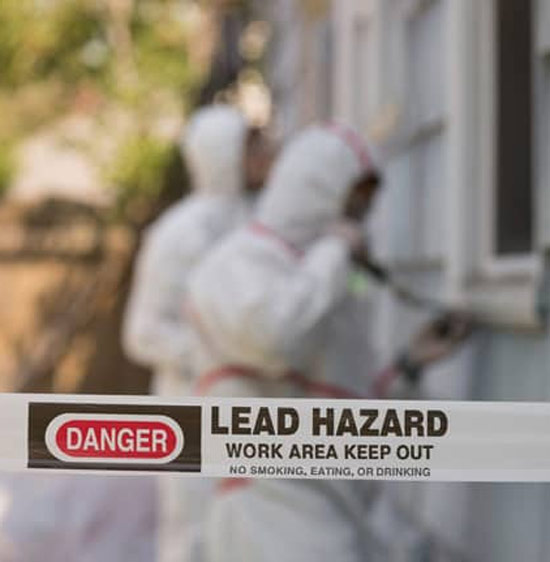Lead Removal Contractors-- Experienced Professionals for Lead Abatement
Lead Removal Contractors-- Experienced Professionals for Lead Abatement
Blog Article
Vital Devices and Methods for Reliable Lead Infraction Cleaning
Attending to lead offenses effectively requires a detailed approach that blends the right tools with calculated techniques. Simultaneously, the usage of specialized cleaning tools, such as HEPA vacuum cleaners and lead-specific cleaning representatives, is critical for extensive impurity removal. Effective control methods, including plastic bed linen and negative air stress systems, are important to protect against the spread of harmful products.
Individual Safety Equipment
Individual safety devices (PPE) is a critical element in the reliable monitoring of lead contamination cleaning. The essential PPE for lead cleaning consists of respirators, safety clothing, handwear covers, and eye defense.
Respirators, particularly those outfitted with HEPA filters, are vital for filtering system airborne lead particles, stopping breathing. Protective clothing, including coveralls and disposable suits, prevents lead dirt from adhering to employees' garments, minimizing the threat of additional contamination.
Moreover, strenuous training on the appropriate use and maintenance of PPE is necessary. Employees need to be informed on wearing and doffing treatments to avoid contamination. Normal inspections and replacements of PPE elements are essential to maintain their safety abilities, ensuring a safe and certified cleanup operation.
Specialized Cleaning Equipment

An additional essential tool is the wet/dry vacuum, which can successfully tidy up both dust and fluid pollutants. These vacuum cleaners usually include HEPA filters to give an added layer of safety. Damp cleans or tack towels are also crucial for surface area cleaning; they are particularly developed to capture and hold lead bits, decreasing the risk of spreading out contamination.
For even more stubborn down payments, specialized lead-removal cleansing representatives are needed. These representatives are created to break down lead fragments, making them much easier to eliminate. Scrub brushes with strong bristles can aid in this procedure, particularly on harsh surface areas where lead dirt often tends to stick more highly.
Furthermore, encapsulants are used to seal lead-contaminated surfaces, stopping the launch of lead dirt. These specialized paints and finishings are designed to stick to numerous substrates, offering a long-term option for lead containment.
Effective Control Approaches
Efficient containment methods are essential in mitigating the spread of lead contamination throughout cleaning activities. Implementing durable control techniques ensures that lead particles do not move to untouched locations, therefore shielding both employees and the setting. One main technique is making use of plastic sheet to secure off contaminated zones. Heavy-duty polyethylene barriers can be installed from flooring to ceiling to create a regulated workplace, dramatically reducing the risk of airborne lead dirt dispersal.

To improve control, encapsulants can be related to surface areas that are not being eliminated or interrupted. These specialized coatings bind lead dirt, minimizing its accessibility for resuspension. In addition, all personnel have to wear proper Personal Safety Equipment (PPE), including respirators and non reusable matches, to avoid contamination spread.
Safe Disposal Practices
Making sure secure disposal practices is an important element in the administration of lead contamination clean-up. Appropriate disposal mitigates the danger of lead coming back the atmosphere and jeopardizing public health. The primary step is to recognize and set apart lead-contaminated waste from other materials. Safe and secure containment making use of durable, leak-proof containers is vital to prevent splilling during transport.
Transferring lead waste requires adherence to strict standards. Utilizing qualified dangerous waste providers makes sure that the products are handled properly. Documents, including manifests outlining the kind and amount of waste, ought to come with deliveries to track the waste from the site of origin to its last disposal location.
Designated hazardous waste disposal facilities are equipped to handle lead-contaminated products safely. These centers often employ innovative methods such as stablizing, solidification, or chemical treatment to reduce the effects of the lead prior to disposal. Landfilling in specialized, lined locations that stop leachate from contaminating groundwater is an usual practice for last disposal.
Regular training for workers associated with lead waste disposal is critical to preserve safety and security requirements and stop accidental exposure. By sticking to these practices, companies can substantially minimize click to read the ecological and health and wellness effects related to lead contamination.
Regulatory Conformity Tips

Following regulatory conformity is vital in the effective execution of lead contamination cleaning. Recognizing and adhering to government, state, and local regulations makes sure not only the security and health and wellness of people however additionally the legal and financial wellness of the clean-up company. The Environmental Security Firm (EPA) establishes stringent standards, such as the Lead Improvement, Repair Service, and Painting (RRP) Guideline, which mandates appropriate accreditation and training for page contractors dealing with lead-based activities.
Compliance starts with a detailed evaluation of applicable regulations and guidelines. Organizations should stay upgraded on any kind of legal adjustments, which can be facilitated via routine training sessions and subscribing to industry updates. Documents is an additional critical compliance facet; preserving in-depth documents of all activities, consisting of evaluation records, staff member training logs, and disposal manifests, is important.
Additionally, engaging with accredited lead inspectors or take the chance of assessors makes certain that lead risks are appropriately recognized and mitigated. Companies need to impose using Personal Protective Devices (PPE) and guarantee that security procedures are purely adhered to. Clear interaction with stakeholders, consisting of staff members, clients, and governing bodies, will cultivate a culture of compliance and responsibility, ultimately adding to a safer and much more efficient lead clean-up process.
Final Thought
Reliable lead violation clean-up requires the combination of specialized tools and calculated methodologies to guarantee security and efficacy. Utilizing HEPA vacuums, specialized cleaning representatives, and efficient containment techniques such as plastic sheet and negative atmospheric pressure systems is necessary. Individual safety devices (PPE) safeguards workers from direct exposure, while risk-free disposal practices and rigorous adherence to regulatory compliance are vital for sensibly our website handling contaminated materials. Collectively, these steps dramatically mitigate health risks and add to a cleaner environment.
Report this page